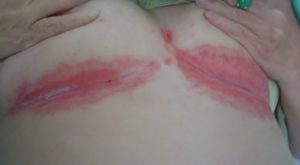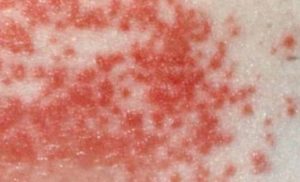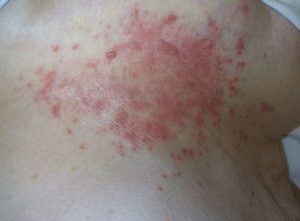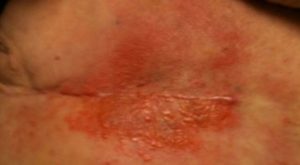Yeast or fungal infection can be the cause of rash under breast. Although it may not be as serious as such, sweating and heat rash can cause very itchy, burning or irritating rash between breasts. Diabetes and breast cancer are some of the medical conditions linked to rash under your breast. It can be worrisome especially if cancer of the breast is involved.
This article provides you with the pictures, causes and treatment on how to get rid of the rash.
A rash under breast is a very common problem. It’s mostly a form of irritant dermatitis known as intertrigo characterized by inflammation of skin folds. The rash is mostly caused by, excessive sweating, heat, lack of air circulation and wearing tight bra that rubs against the breasts. Other causes include fungal infection and allergy.
Related articles:
A breast fungus is a common term for a fungal yeast infection of the skin overlying the breast. It does not imply an infection of the deeper breast tissue. The area under the breast (inframammary fold) is particularly prone to fungal infections in women for a number of reasons that makes this region ideal for fungi to thrive. If you notice a rash under your breast taking too long to go away, please see your health care provider as soon as possible.
Rash under breast pictures
What does a rash on breast look like? It is an irritation on the skin that can be painful, itchy and scaly. Mostly rashes on the skin are characterized red patches that can be circular on the affected skin. Below are pictures of rash under the breast.

What causes a rash between breasts?
A rash is a symptom that causes the affected arear of the skin to turn red and blotchy or swell. The rash may cause spot that are bumpy, scaly, and flaky or filled with pus. Depending on what is causing the rash the symptoms may vary from one person to the other. The most common causes will include;
1. Contact dermatitis or intertrigo.
Contact dermatitis (skin inflammation) is caused by an adverse reaction something that touches the skin, including chemicals found in detergent, soap or a fragrance. For example, you may develop a rash on your breast from wearing a shirt that was washed with a particular detergent or treated with a chemical. Metal, such as a necklace rubbing against your chest, can cause a breast rash. Other forms of contact dermatitis include exposure to certain plants, such as poison oak or ivy, an animal bite, or an insect sting. Allergies to foods, for example, peanuts, shellfish, strawberries or avocados, can also cause a breast rash. The common causes of this would include;
- A hidden moist ,warm skin
- Poor body hygiene
- Excessive sweating on the parts of the skin folds.
- Friction of the skin folds
- Lack of air circulation around the breast
2. Allergy
Allergic reaction of medicines, topical lotions, detergents and foods can cause rash under breast. The rash can range from mild and minor symptoms to life-threatening cases that an anaphylactic shock is presented, which can be started with swelling.
If you notice a rash under your breast and you suspect it could be as a result of the above, you could get yourself some anti-itching cream. Apply the cream two time a day. If the rash does not disappear please see your health care provider as soon as possible.
3. Heat rash under breast
Prickly heat, also known as malaria rubra, is an itchy rash of small, raised red spots that causes a stinging or prickling sensation on the skin. The rash is made up of tiny spots or bumps that are surrounded by an area of red skin.

The spots sometimes look like tiny blisters and can cause:
- mild swelling
- itching
- a stinging or intense prickling sensation
4. Yeast Infection under breast
Fungal infection is a common cause of an itchy rash under the breast. Mostly caused by a yeast known as candida. Candida-related skin rashes are typically red, but white, scaly areas may form as well. Uncontrolled diabetes, antibiotic use, chronic steroid use, obesity and HIV are risk factors for Candida skin infections. Fungal infection tend to clear up quickly with topical antifungal creams.

A breast fungus is a common term for a fungal infection of the skin overlying the breast. It does not imply an infection of the deeper breast tissue. The area under the breast (inframammary fold) is particularly prone to fungal infections in women for a number of reasons that makes this region ideal for fungi to thrive.
Most fungal skin infections persist without medical treatment therefore it has to be diagnosed and treated as soon as possible. The infection can spread and eventually affect the top of the breast and even the cleavage. One of the consequences of a long term fungal skin infection is a dark discoloration of the skin which can be unsightly. There are usually no other significant complications of a breast fungus. The symptoms are limited to the skin. Fungal skin infections almost never penetrate into deeper tissue to infect internal organs.
This kind of infection is superficial and does not penetrate deeper tissue in your breast. If you maintain proper hygiene, the infection is most likely to disappear after same few days. The other common symptoms would include:
- Skin discoloration
- A thin and clear discharge under your breast.
- Itching
- A red rash due to inflammation
- Unusual bad smell.
5. Excessive sweeting
Candida skin infections can occur on almost any area of the body, but they are more commonly found in intertriginous regions. This is where two skin areas touch or rub together. The fungus thrives in warm, moist, and sweaty conditions.
Normally, your skin acts as an effective barrier against infection. However, any cuts or breakdown in the superficial layers of the skin may allow the fungus to cause infection. Candida becomes pathogenic, or capable of causing disease, when conditions are favorable for it to multiply. Hot and humid weather, poor hygiene, or restrictive clothing may produce these conditions.
6. Inflammatory breast cancer
Inflammatory breast cancer (IBC) is a rare and aggressive form of breast cancer. According to the American Cancer Society, about 1% of all breast cancer cases in the United States are inflammatory breast cancers.

Inflammatory breast cancer usually starts with the reddening and swelling of the breast instead of a distinct lump. IBC tends to grow and spread quickly, with symptoms worsening within days or even hours. It’s important to recognize symptoms and seek prompt treatment. Although inflammatory breast cancer is a serious diagnosis, keep in mind that treatments today are better at controlling the disease than they used to be.
Symptoms of inflammatory breast cancer rash include the following:
- Breast skin may turn dark or appear bruised.
- Persistent itching of the breasts at early stages.
- Irritation and a small rash under breast or different points of the breast.
- Dimpling on the breast may occur.
If you suspect that your breast rash is caused by inflammatory breast cancer, see a doctor for proper diagnosis and treatment. IBC is categorized as stage 3 cancer. A biopsy is usually done and treatment commenced aggressively.
7. Diabetes causing rash under breast.
Most diabetes patients are prone to fungal infection, bacterial infection, and itching. Most of diabetic people are prone to many common skin condition. Diabetes affects any part of the body. Other skin problems happen mostly or only to people with diabetes. These include diabetic dermopathy, necrobiosis lipoidica diabeticorum, diabetic blisters, and eruptive xanthomatosis. In a yeast –like Most often develop painful rashes on moist area of the skin. This may result into a yeast-like fungus called candida albicans
The fungus “creates a red, itchy rash, frequently surrounded by small blisters and scales that is usually found in warm, moist folds of the skin like armpits or between the toes.” Other parts that may be affected include under the breast, between thighs and between buttocks.
The symptoms would include:
- Localized itching
- The rash may become painful due to inflammation
8. Scabies, eczema and shingles
A rash under breast caused would also be as a result of scabies, eczema or shingles. This are skin disorders that produces sings similar to those of rash caused by allergies and insect bites on the breast area.
- Scabies is a severe itchy skin disorder. It is contagious and is caused by scabies mite. If you have a skin rash composed of small red bumps and blisters under breast and other parts of the body, you could be suffering from scabies.
- Eczema is also called atopic dermatitis. It is a possible cause of an itchy red rash on breast. It is characterized by an itchy red rash that is dry or scaly.
- Shingles is caused by a viral infection. It can cause a painful rash under the breast area. Shingles bumps, chickenpox or herpes zoster bumps appear as a single stripe of blisters on the affected area
9. Lupus
Lupus- an autoimmune disease resulting when your body immune system attacks different healthy body tissues. The causes are unknown but it is believed to be caused by hormonal and genetic factors.
The lupus rash occurs symmetrically on the body. You can therefore expect both breast to be affected with the lupus rash (butterfly rash)
Lupus has not treatment. Only management medications are given. Most of these include nonsteroidal anti-inflammatory drugs (NSAIDs) that reduce the effect of the immune system on the affected tissue. Pain and fever that is associated with lupus may be treated using over-the-counter NSAIDS such as naproxen sodium [Source – Mayo Clinic]
Itchy Red rash under breast
An itchy red rash under breast is most likely to be a breast fungus, a common term for a fungal infection of the skin overlying the breast. It does not imply an infection of the deeper breast tissue. Fungal infection are common, with the area under the breast being particularly prone to this kind of infection for women. The area under the breast makes it ideal for fungi to thrive.
Yeasts thrive in cavities lined by living tissue but the immune system usually prevents it from causing an infection. The dark, warm and moist conditions under the breast is ideal for any skin fungus to thrive and even spread with time.
Sometimes the symptoms are not as obvious. Some women may only experience mild itching and a skin-colored ‘dust’ on the bra or upon scratching. The skin symptoms can extend beyond the inframammary folds to affect the breast and even the chest. Many women are concerned about the dark discoloration of the skin that occurs with long-standing infections.
Rash under breast won’t go away
Rash under breast may be a symptom of certain fungal, bacterial, or viral infections as well. If you have a rash that does not improve or go away within a few days, you should consult your health care provider. Treating the underlying cause of the rash might help cure the rashes and get rid of them faster.
Otherwise, you may get some over- the- counter anti-itching cream that you may apply. If the itching and the rash does not go way, you will need to treat the underlying cause of the rash under breast. Please see a health care provider to be advised on the best possible medication.
Rash under breast treatment
A breast fungus may appear similar to other skin diseases and it is important that your doctor diagnose a skin fungal infection before commencing treatment. Using an antifungal ointment for a few months usually resolves the infection although oral antifungals may have to be considered in severe cases.
There are several things you can do to ease your symptoms:
a) Avoid excessive heat and humidity
If you need to go outside, spend time in the shade or take a small fan with you. Further exposure to the heat will cause you to sweat more and may make your rash worse. Drink plenty of fluids to avoid dehydration, especially in hot weather.
b) Wear loose cotton clothing.
Avoid wearing synthetic fibers, such as polyester and nylon, which trap heat easier than natural fibers
c) Keep your skin cool
A cool bath or shower will cool you down, soothe your skin and help prevent further sweating. Staying in an air-conditioned room for a few hours a day will also provide considerable relief. You can also use a cold compress, but don’t leave it on the skin for longer than 20 minutes.
d) Use calamine lotion
However, avoid using it on your face and always follow the instructions. Antihistamine tablets may help control itching – but consult your GP first as they’re not always suitable
e) Surgery, chemotherapy and radiation therapy.
When the cause of the rash is known to be cancer, then your doctor might prescribe one of this, depending with, the stage the cancer is in, your age, and the amount involved.
Chemotherapy is used to shrink the cancerous tumor and kill cancer cells. The tumors are then removed through surgery. If any cancerous cells are left behind, radiation may be applied to kill them. Some doctors may also include hormone therapy as part of the treatment for breast cancer rash.
Rash under breast home remedies
The treatment of rash under breast can be done by both using home remedies and doctor’s prescription (which is most advised if the rash do not disappear after one week). For home remedy the following would help reduce the irritation and itchiness;
Olive oil
Applying olive oil on the legs and arms part with rash. Olive oil is rich in vitamin E and antioxidants, which help soothe your skin and reduce itching. You could also use a combination of olive oil and honey. Simply rub the mixture a few times daily until the rash heal completely.
Castor oil and coconut oil also help heal rashes naturally. A combination of vitamin E oil and liver oil is thus a good remedy.
Baking soda
You could also use baking soda, which help dry skin rashes. It also relieves the itching and inflammation associated with rashes. Add a 50 grams of baking soda to 150 milliliters of water. Apply the mixture on the affected area, leave it on for a few minutes before rising it off. Do this repeatedly for a few days. Note you can use coconut oil in place of water to make a paste that you can apply on the affected area.
(You should not leave baking soda on your skin for long as this would cause further irritation).
Oatmeal
Due to the soothing and anti-inflammatory properties of oatmeal, it’s good for alleviating skin irritation and inflammation. It’s thus excellent for rashes caused by eczema, sun burn, chicken pox and allergies.
Grind oatmeal in a blender, combine one-half cup of oatmeal, a quarter cup of milk powder and two tea spoon of honey. Put this mixture in a muslin cloth, tie and place it in a bath tab filled with warm water. Soak in the milky bath water for 20 minutes. Pat dry and moisturize your skin, repeat daily for a few days.
Aloe Vera
Aloe Vera has anti-inflammatory, emollient, antibacterial and antifungal properties. It’s excellent for treating number of skin ailments including rashes. Apart from healing, it also soothes the skin, relieves itching and reduce redness.
- Extract fresh Aloe Vera gel from an aloe leaf.
- Apply it on the affected area.
- Leave it on for at least 20 minutes, and then rinse it off.
- Do this at least three times a day until the rash clears.
If you do not have fresh aloe Vera gel, you can buy aloe Vera gel or extract from any retail store near you.
Cold compress
A cold compress can be beneficial in reducing rashes, especially those caused by heat, insect bites, poison ivy and shingles. It helps ease itching, swelling and inflammation, and can be particularly useful if a rash begins to develop into blisters.
Apple cider vinegar
Raw and organic apple cider vinegar is another excellent home remedy to treat skin rashes and calm the itching. Moreover, its acetic acid content helps fight skin infections that could be causing or aggravating the problem.
- Dip a cotton ball in apple cider vinegar and place it on the affected area.
- Leave it on for a few minutes, and then remove the cotton ball.
- Do this several times a day for a few days or until your rash clears.
Note: If apple cider vinegar causes irritation, try diluting it with water before applying it. If the irritation persists, then try another remedy.
Sources and References
- http://www.medicinenet.com/heat_rash/article.htm
- Fungal infection under breast http://www.healthline.com/health/skin/candida-fungus

I just like the helpful information you provide to your articles. I will bookmark your weblog and check again here regularly. I’m quite certain I will be informed many new stuff proper right here! Good luck for the following!
Things are all very open using a clear clarification from the challenges.
It absolutely was truly informative. Your website is very helpful.
Thanks for sharing!